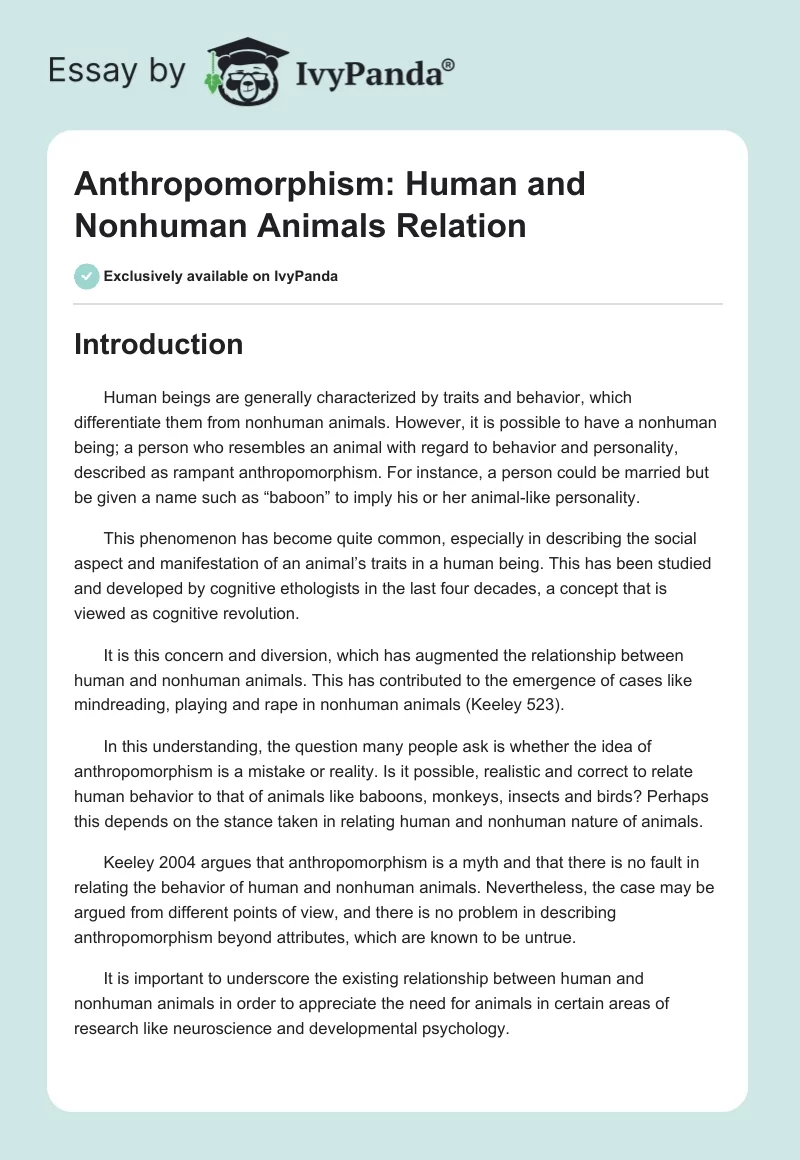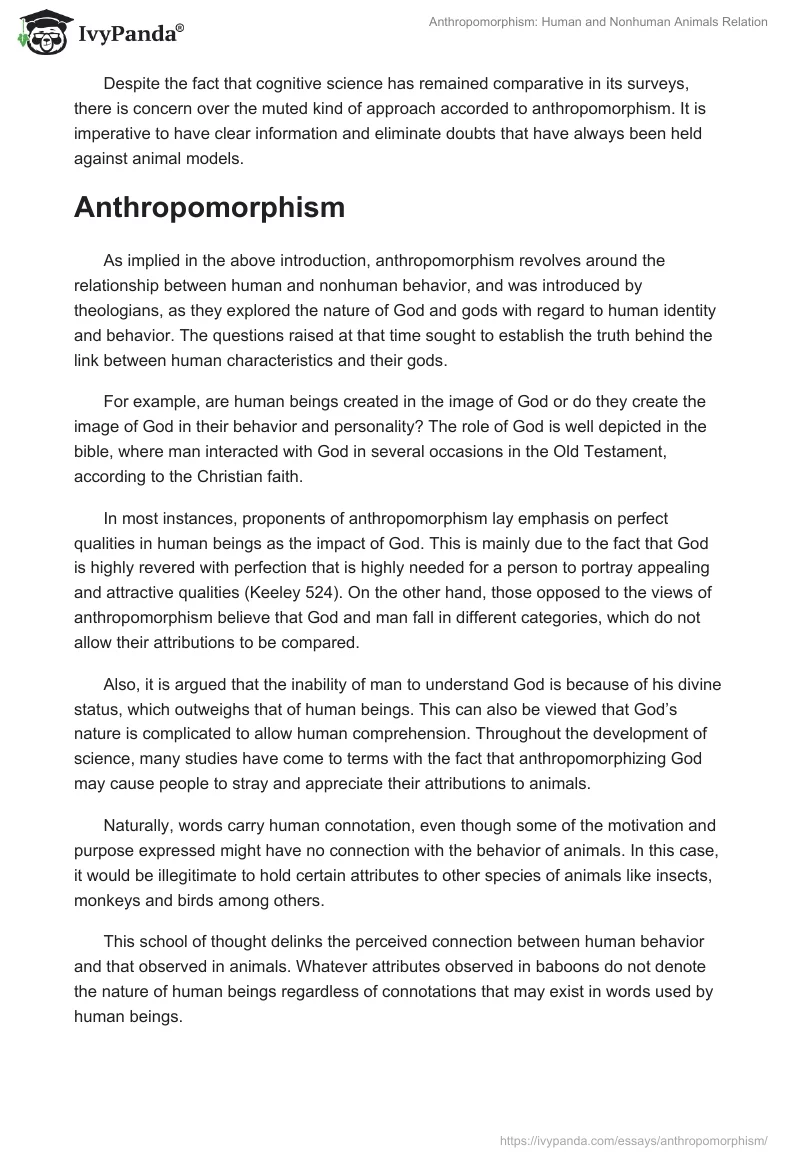Introduction
Human beings are generally characterized by traits and behavior, which differentiate them from nonhuman animals. However, it is possible to have a nonhuman being; a person who resembles an animal with regard to behavior and personality, described as rampant anthropomorphism. For instance, a person could be married but be given a name such as “baboon” to imply his or her animal-like personality.
This phenomenon has become quite common, especially in describing the social aspect and manifestation of an animal’s traits in a human being. This has been studied and developed by cognitive ethologists in the last four decades, a concept that is viewed as cognitive revolution.
It is this concern and diversion, which has augmented the relationship between human and nonhuman animals. This has contributed to the emergence of cases like mindreading, playing and rape in nonhuman animals (Keeley 523).
In this understanding, the question many people ask is whether the idea of anthropomorphism is a mistake or reality. Is it possible, realistic and correct to relate human behavior to that of animals like baboons, monkeys, insects and birds? Perhaps this depends on the stance taken in relating human and nonhuman nature of animals.
Keeley 2004 argues that anthropomorphism is a myth and that there is no fault in relating the behavior of human and nonhuman animals. Nevertheless, the case may be argued from different points of view, and there is no problem in describing anthropomorphism beyond attributes, which are known to be untrue.
It is important to underscore the existing relationship between human and nonhuman animals in order to appreciate the need for animals in certain areas of research like neuroscience and developmental psychology.
Despite the fact that cognitive science has remained comparative in its surveys, there is concern over the muted kind of approach accorded to anthropomorphism. It is imperative to have clear information and eliminate doubts that have always been held against animal models.
Anthropomorphism
As implied in the above introduction, anthropomorphism revolves around the relationship between human and nonhuman behavior, and was introduced by theologians, as they explored the nature of God and gods with regard to human identity and behavior. The questions raised at that time sought to establish the truth behind the link between human characteristics and their gods.
For example, are human beings created in the image of God or do they create the image of God in their behavior and personality? The role of God is well depicted in the bible, where man interacted with God in several occasions in the Old Testament, according to the Christian faith.
In most instances, proponents of anthropomorphism lay emphasis on perfect qualities in human beings as the impact of God. This is mainly due to the fact that God is highly revered with perfection that is highly needed for a person to portray appealing and attractive qualities (Keeley 524). On the other hand, those opposed to the views of anthropomorphism believe that God and man fall in different categories, which do not allow their attributions to be compared.
Also, it is argued that the inability of man to understand God is because of his divine status, which outweighs that of human beings. This can also be viewed that God’s nature is complicated to allow human comprehension. Throughout the development of science, many studies have come to terms with the fact that anthropomorphizing God may cause people to stray and appreciate their attributions to animals.
Naturally, words carry human connotation, even though some of the motivation and purpose expressed might have no connection with the behavior of animals. In this case, it would be illegitimate to hold certain attributes to other species of animals like insects, monkeys and birds among others.
This school of thought delinks the perceived connection between human behavior and that observed in animals. Whatever attributes observed in baboons do not denote the nature of human beings regardless of connotations that may exist in words used by human beings.
Arguments
One important factor is that anthropomorphism thoughts can be ignored even though they are highly perpetuated by cognitive ethologists, who are viewed as heirs of olden scientists. Most of the arguments put forth concentrate on meta-scientific approach that does not appreciate the use of data in supporting scientific claims.
As a result, the focus is put on what could be considered as appropriate or inappropriate scale during data interpretation and the possibility of finding information outside the scientific scope. Moreover, cognitive ethologists have received backing from several quarters, due to their empirical work. They therefore need to be considered and engaged in discussions before their views concerning anthropomorphism are refuted.
Nature of anthropomorphism
According to Keeley 2004, anthropomorphism cannot be assumed to be related to anecdotalism; the two are independent. It is argued that earlier efforts to associate the behavior of human and nonhuman animals’ behavior were based on anthropomorphic and anecdotal approaches. In most cases, their conclusions were based on the achievements observed among certain animals.
This was communicated in form of stories, which were adopted as true findings, relating the behavior of human beings to that of other species (Keeley 527). The lack of cues in most of these findings was enough evidence and reason to refute information collected from people in the form of stories. In essence, anecdotes cannot be considered as satisfactory evidence that can be used to make conclusions regarding the behavior of animals and their capabilities.
Although it might not be essential to understand the superiority between experimental evidence and anecdotes, it is imperative to emphasize the fact that the two sets of quality are independent. With regard to cognitive ethology, it is possible to have experimental evidence in the absence of anecdotal stories because of their distinct connection.
Taxonomy of anthropomorphic claims
Like many other fields of study, anthropomorphism encompasses a wide range of senses, some of which might not be relevant in the analysis of some cases defining the behavior of human and nonhuman behavior. Different researchers therefore have an array of views in defining the concept of anthropomorphism. For instance, imaginative anthropomorphism relates the image of animals to human beings.
Importantly, a clear line has to be drawn to differentiate this from interpretive anthropomorphism, which argues that certain traits manifested in animals are caused by similar mechanisms recorded by human beings (Keeley 529). The latter approach can however be understood by considering two ways of analysis: the categorical anthropomorphism and situational anthropomorphism.
Categorical anthropomorphism involves the association of traits to nonhuman animals, which do not have attributions. On the other hand, situational anthropomorphism focuses on cases where the behavior of an animal is misinterpreted depending on the existing circumstances.
Interestingly, opponents of anthropomorphism do not always consider the above situational case as the only mistake, since a situational error can only be identified by use of empirical methods. This differs from what is supported by opponents of anthropomorphism.
On this basis, there is no need of carrying out an ethological study to find out the relationship between the display of bared-teeth and smiling in chimps as purported by some scientists. This ought not to be the case since the animals in question are chimps and not human beings; the two are not connected (Keeley 529).
Similarly, the concept of categorical anthropomorphism can be analyzed deeper to determine further distinction. For instance, there are unwarranted attributions of human behavior to certain animals. A good example is “rape” in flies. How can this be possible? It would be ridiculous to adopt search an approach since insects cannot have human behaviors. Nevertheless, such an argument could probably be conceived when dealing with chimpanzees.
This is based on the likelihood of considering insects versus chimps. From this perspective, it is essential to underline the fact that the issue is never the kind of species being considered but rather the traits being attributed to these animals with regard to human beings (Keeley 529). In other words, human behaviors could be attributed to some animals but not to all nonhuman animals.
Another important factor of consideration is that anthropomorphism is not always defined within psychological confines. Such an approach may limit a justified attribution of human behavior to certain animals.
From the above analysis, it is clear that anthropomorphism is a concept that has received a wide range of views throughout history. It is vital to consider several points of view in establishing the relationship between the traits of human and nonhuman animals.
Works Cited
Keeley, Brian. “Anthropomorphism, primatomorphism, mammalomorphism: understanding cross-species comparisons.” Biology and Philosophy 19 (2004): 521–540. Print.


